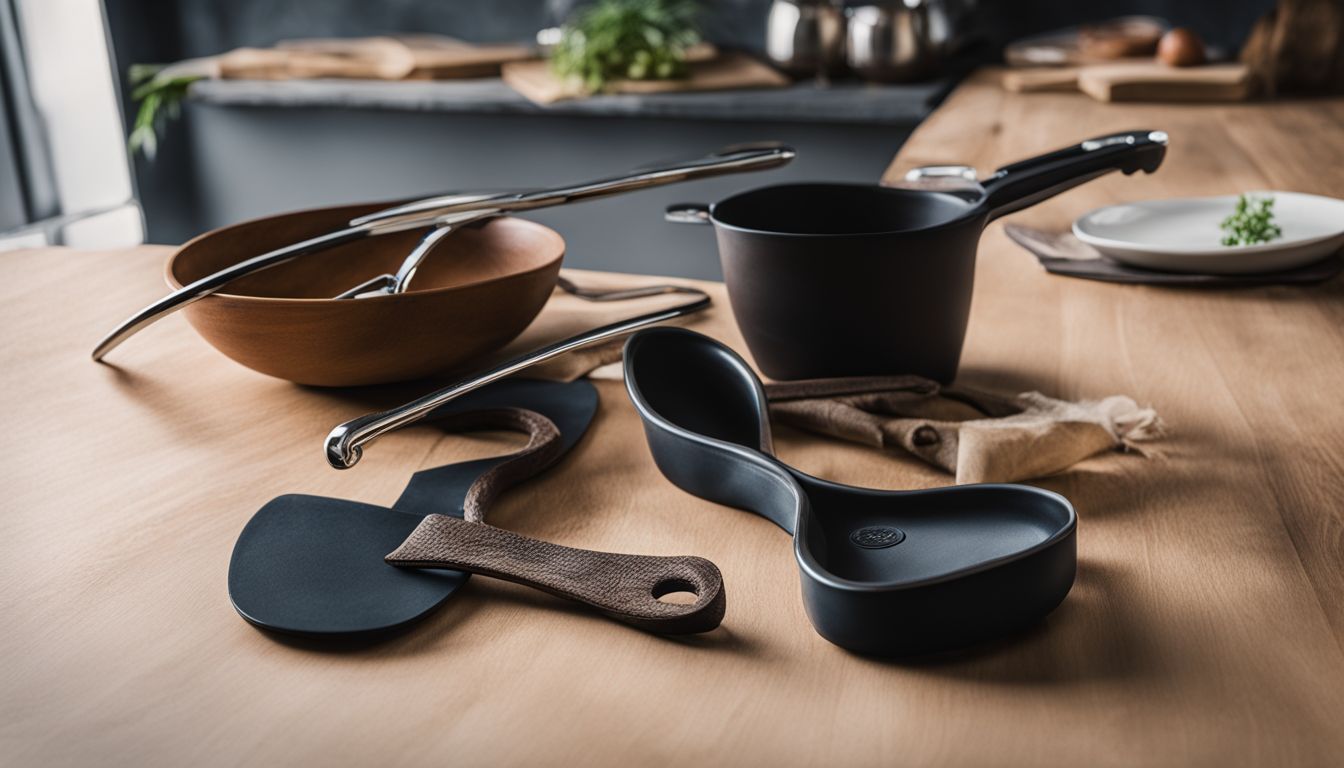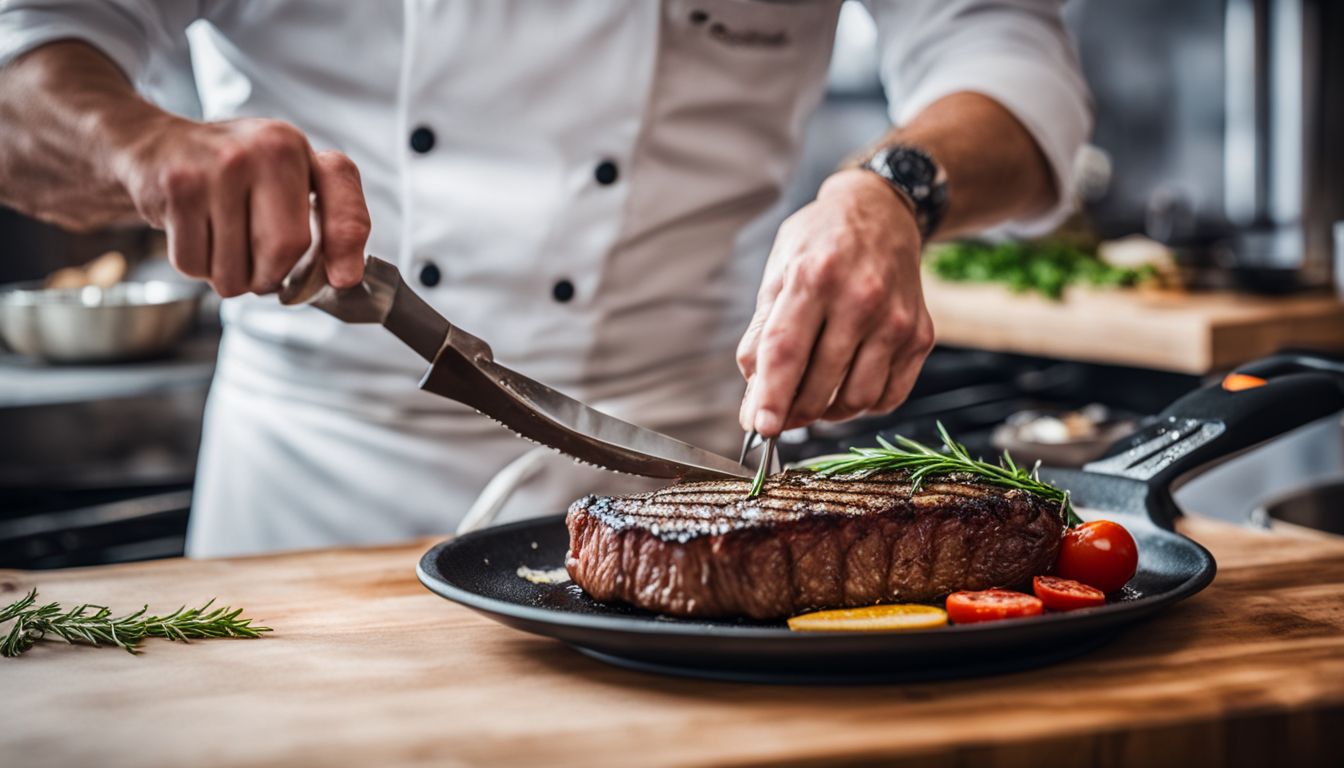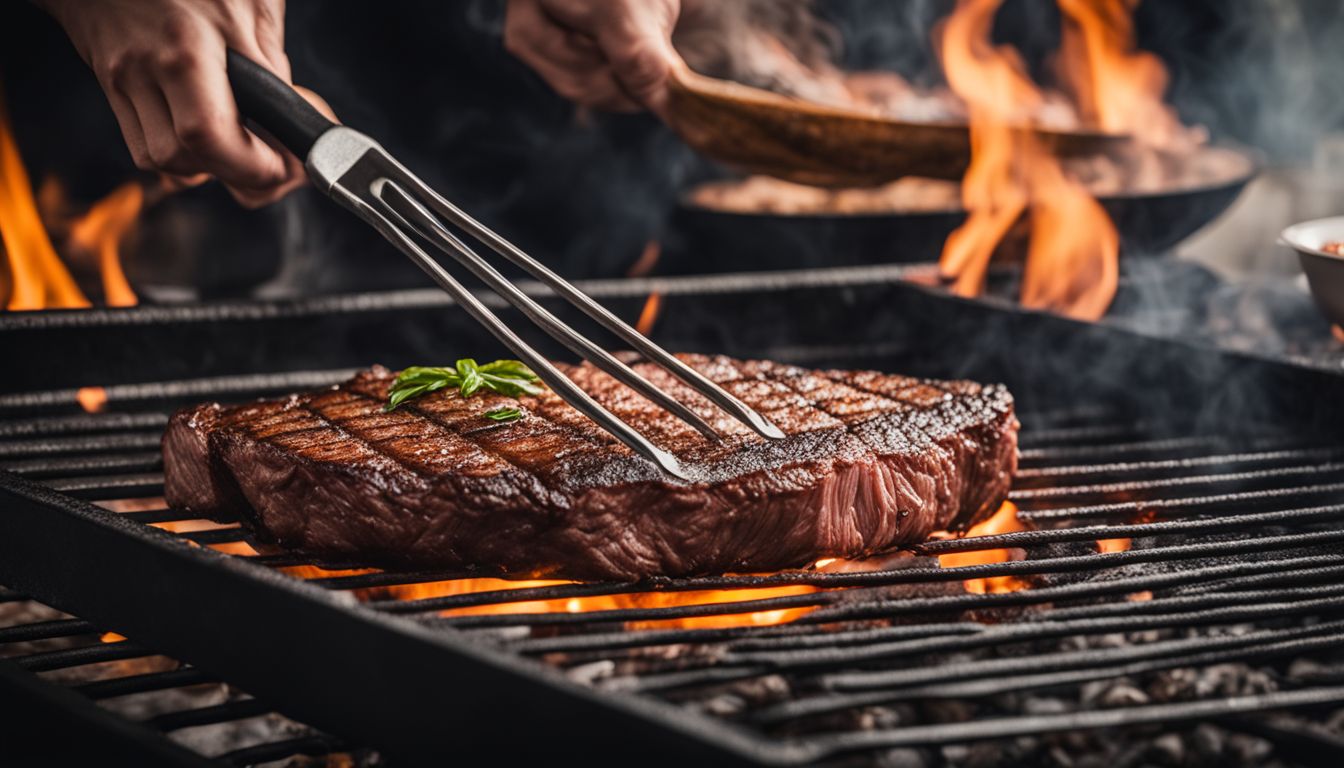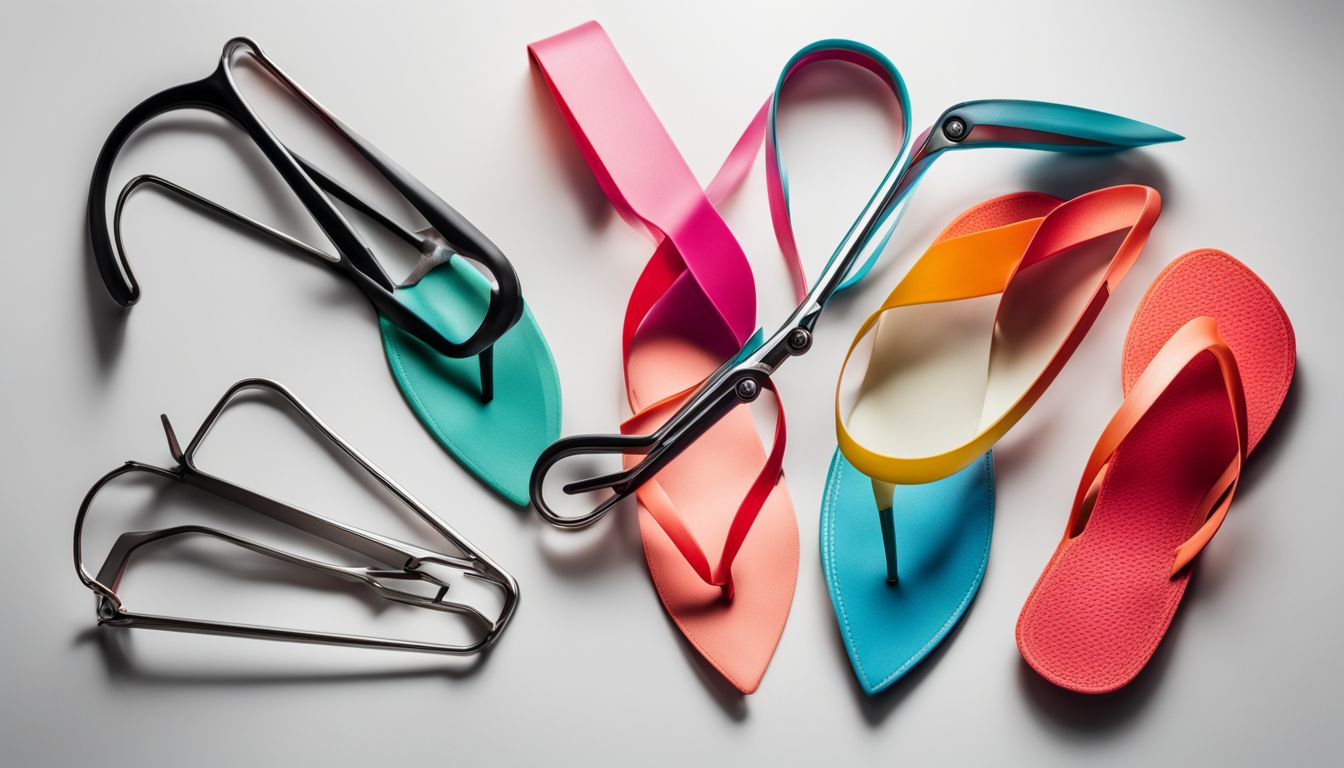Thong Vs Tong: Understanding The Key Differences And Common Misconceptions
Have you ever found yourself confused between the terms ‘thong’ and ‘tong’? You’re not alone. Countless people mix up these words, often leading to some embarrassing situations or misunderstandings.
This article is here to clear the fog surrounding thongs and tongs, from their definitions to their correct usage. Ready for a fascinating journey of language exploration? Keep reading.
Key Takeaways
- Thongs and tongs are often confused, but they have different meanings and uses.
- Thongs are clothes or shoes, while tongs are tools used in the kitchen or at a grill party.
- People often confuse thong and tong because they sound alike, leading to humorous misunderstandings.
- It’s important to understand the proper usage of thongs and tongs to avoid confusion in conversations or writing.
Understanding the Key Differences

The key differences between thong and tong lie in their definitions, origins, and uses.
Definition of thong and tong

Thongs are often clothes or shoes. As clothes, they are a type of underwear made from small strips of fabric. Some people also call flip-flops or sandals “thongs.” You see these items at the beach a lot.
They are made with a strip that goes between your toes and holds onto your foot.
Tongs have nothing to do with what you wear. People use tongs as tools in the kitchen or at a grill party. Made for gripping things, they help pick up hot food like roasted chicken, frankfurters, and corn on the cob without burning fingers! Tongs can also be used near fireplaces to move logs around safely.
Origins and evolution of the words

Long ago, people first used the word “thong”. They took it from Old English. It meant a strip of leather. Now we use it to talk about a type of slim sandal or underwear.
The word “tong” came to us later. The Dutch made this word first and they used it for a tool for picking up things. Today, most people use tongs in the kitchen to grab hot or cold food safely.
Both these words have changed over time with language evolution and usage shifts. So now, they each have their own spot in our vocabulary with clear meanings and uses that don’t cross paths much.
Common Misconceptions

Many people confuse the words “thong” and “tong,” thinking they are synonymous when they actually have completely different meanings.
Confusing the words

People often get lost in the sound of thong and tong. They use these words wrongly because they sound alike. The truth is, these words have different meanings.
Getting confused can lead to funny mistakes! You might say “thong” when you mean “tong”. This could make people laugh at a party or dinner. It’s good to know the right word for what you’re talking about.
Don’t let the same sound trick you into using the wrong word!
Regional differences in usage

There are regional differences in how people use the words “thong” and “tong.” In some areas, these words may be used interchangeably or have different meanings altogether. For example, in the North Cascades region, which is home to the Thompson population, there are distinct clusters within this group that have their own cultural and linguistic variations.
This means that even within a relatively small area, you can find differences in how people understand and use these words. Understanding these regional differences is important for effective communication and cultural awareness.
Creative language use

Thongs and tongs are often used creatively in language, leading to some confusion. People may use these words in a playful or imaginative way, creating new meanings for them. However, it’s important to remember that in their original context as kitchen utensils, thongs and tongs have specific definitions and uses.
While creative language use can be fun, it’s essential to understand the proper usage of these words before using them in a different or unconventional manner.
One example of creative language use is when people refer to flip-flops as “thongs” instead of using the correct term. This play on words can be entertaining but might also lead to misunderstandings if someone is expecting cooking utensils instead of footwear when they hear the word “thong.” Similarly, people might make puns or create humorous phrases involving tongs, like “tong wars” or “tong twisters,” which adds an element of wordplay but may not reflect their actual function in the kitchen.
Remember that while creative language use is enjoyable and allows for exploration with words, it’s crucial to distinguish between its imaginative applications and the original meaning behind thongs and tongs as culinary tools.
Proper Usage

When using the word “thong,” it is important to consider the context in which it is being used. For example, “I bought a new thong bikini for my vacation” versus “I used tongs to flip the burgers on the grill.”.
Context matters

In language, context matters a lot. It plays an important role in how we understand and use words like thongs and tongs. The meaning of these words can change depending on the situation or setting they are used in.
For example, when talking about clothing, a thong refers to a type of underwear with a narrow strip at the back. But when it comes to kitchen utensils, tongs are long-handled tools used for gripping and lifting objects.
Understanding the context is key to using these words correctly. It’s important to pay attention not only to the definition but also to where and how they are being used. By considering the surrounding information or circumstances, we can avoid confusion or misinterpretation.
Examples of different contexts

Thongs and tongs are two words that can cause confusion because they sound similar. However, they have different meanings and are used in different contexts. Thongs are often associated with underwear, specifically a type of skimpy underwear worn by both men and women.
On the other hand, tongs refer to kitchen utensils that have two long arms or prongs used for gripping or picking up items, such as food or hot dishes.
In terms of usage, thongs are typically worn as an undergarment for aesthetic purposes or to prevent visible panty lines. They are commonly used in swimwear and lingerie. Tongs, on the other hand, play a practical role in the kitchen.
They are designed to help handle hot objects without burning your hands. Tongs can be made from various materials like metal or silicone and come in different sizes depending on their intended use.
Understanding these differences is important to avoid misunderstandings when using these words in conversations or writing. Using thong instead of tong when referring to kitchen utensils could lead to confusion or raised eyebrows since thong is not commonly associated with cooking tools.
Similarly, using tong instead of thong when talking about underwear might result in some strange looks.
Exceptions to the rules

There are exceptions to the rules when it comes to using thongs and tongs. While thongs are typically used for smaller items like flip-flops or underwear, there may be instances where they can also be used for larger items.
Similarly, tongs are commonly used for gripping and lifting larger objects, but there may be cases where they can be used for handling smaller items as well. These exceptions depend on the specific context and purpose of use.
It’s important to consider the size, weight, and nature of the item being handled when deciding whether to use a thong or a tong.
In addition, regional variations in usage can also play a role in determining when exceptions to the rules apply. Different cultures or regions may have different conventions regarding the use of thongs and tongs.
Practice Exercises

Test your knowledge and improve your understanding of thongs and tongs with our fun practice exercises. Can you correctly identify the usage of each word? Try creating sentences using both words to reinforce your understanding.
Don’t miss out on this opportunity to become an expert in distinguishing thongs from tongs!
Identifying correct usage
To ensure you’re using thong and tong correctly, it’s important to understand their distinct meanings. A thong is a narrow strip of material worn as underwear or on sandals. On the other hand, a tong is a tool used for picking up or turning things.
Remember that when it comes to usage, context matters. For example, you would use tongs to grip hot food on the grill or in the kitchen, while thongs are not suitable for these tasks.
Practice exercises can help you differentiate between thongs and tongs more effectively. By creating sentences with both words and identifying correct usage in various contexts, you can improve your understanding and avoid confusion.
Creating sentences with both words
Now that you have a better understanding of the key differences between “thongs” and “tongs,” it’s time to practice using these words in sentences. This will help solidify your knowledge and ensure that you use them correctly in the future.
Try creating sentences that showcase the proper usage of both words in different contexts. For example, you could write a sentence like, “I used tongs to flip the steaks on the grill,” to demonstrate how “tongs” is used when referring to kitchen utensils.
On the other hand, you could write a sentence like, “She accidentally wore her thong outside instead of underwear,” to show how “thong” is used when talking about undergarments. Remember, context matters when using these words, so make sure your sentences accurately reflect their intended meaning.
Common Mistakes to Avoid

Using tongs for grilling can result in melted handles, while using thongs for serving food can be unhygienic. Read on to learn more about these common misconceptions and how to avoid them.
Using tongs for grilling
Using tongs for grilling is a common practice, but it’s important to use them correctly to avoid mistakes. One common mistake is using the same pair of tongs for both cooked meat and cooked fish.
This can lead to cross-contamination and the spread of bacteria. To prevent this, it’s best to have separate tongs for each type of food.
Another mistake to avoid is using metal tongs on delicate surfaces. Metal tongs can scratch and damage non-stick cookware or other delicate surfaces like glass or porcelain. Instead, consider using silicone-tipped tongs which are gentle enough to keep these surfaces intact.
Additionally, proper sanitation of your tongs is crucial. After each use, make sure to wash them with hot soapy water and thoroughly dry them before storing them away. This will help prevent the growth and spread of bacteria.
Using thongs for serving
Many people mistakenly use thongs for serving food, but this is a common mistake that should be avoided. Thongs are not meant to be used as serving utensils, and using them in this way can lead to cross-contamination and unsafe food handling practices.
Instead, tongs should be used for serving food. Tongs are specifically designed with long handles and gripping ends that allow you to safely pick up and serve items without touching them directly with your hands.
This helps maintain proper hygiene standards in the kitchen and prevents the spread of bacteria. So remember, when it comes to serving food, always reach for tongs instead of thongs.
Thong underwear may have their place in fashion and comfort, but they definitely do not belong in the kitchen when it comes to serving food. Using tongs for serving ensures that you can handle hot or delicate items without risking burns or damage.
Thongs are made of different materials like cotton or bamboo that may not withstand high heat or provide a secure grip on slippery foods. On the other hand, tongs offer better control and stability when transferring items from one plate to another or from a cooking surface to a dish.
Using tongs on non-stick cookware
Using tongs on non-stick cookware can cause damage to the coating. When you use metal tongs, they can scratch and scrape the surface of your non-stick pans, making them less effective over time.
To avoid this issue, it is recommended to use silicone or wooden tongs instead. These materials are gentler on the pan’s coating and will help to preserve its non-stick properties.
There are different types of tongs available for various cooking purposes, and each has its pros and cons when it comes to using them on non-stick cookware. Silicone-tipped tongs are a popular choice as they offer heat resistance and protection for your pans.
Additionally, wooden tongs provide a safe alternative but may not be suitable for high-heat cooking.
Another important thing to consider when using non-stick cookware is the amount of oil or cooking spray you use. Applying too much vegetable oil can lead to a buildup that could harm the coating over time.
It is best to follow the manufacturer’s instructions regarding oil usage or opt for healthier cooking options that require little to no added fats.
Tips for Avoiding Mistakes

To avoid mistakes, remember that tongs are used for gripping and lifting objects, while thongs are a type of underwear or sandals. Use the right tool for the right job to ensure proper usage.
Understanding the purpose of tongs and thongs
Tongs and thongs are two different tools used in the kitchen for specific purposes. Tongs are long, metal utensils with two arms that can be squeezed together to grab and hold onto things, like grabbing a hot piece of meat from the grill or turning food while cooking.
They are sturdy and designed for handling larger items safely. On the other hand, thongs refer to skimpy underwear usually worn by women. They have no place in the kitchen! So remember to use tongs when you need to handle hot or large items while cooking, and leave your thongs for fashion purposes only.
To avoid any confusion or mistakes, it’s important to understand the purpose of each tool. Tongs are meant for food handling and grilling tasks where you need precision control over what you’re picking up or moving around.
Knowing when to use each tool
To avoid confusion and prevent mistakes, it’s important to know when to use each tool – thong or tong. The key is understanding the purpose of these tools and their intended applications.
Tongs are typically used for gripping and lifting larger items, such as flipping meat on a grill or serving salads. On the other hand, thongs are better suited for handling smaller items, like flipping delicate fish fillets or turning vegetables in a pan.
By using the right tool for the job, you can ensure proper tool application and prevent errors.
Remember that context matters when deciding which tool to use. For example, if you’re grilling burgers on a barbecue, tongs would be the appropriate choice because they provide a secure grip on larger food items.
However, if you’re sautéing shrimp in a pan, using thongs allows for more precision when turning them over without damaging their shape.
Thongs vs Tongs: Contextual Differences

Thongs are typically used for smaller items, while tongs are better suited for larger objects.
Thongs for smaller items
Thongs are a type of underwear that is perfect for smaller items. These triangular knickers provide very little coverage, especially at the back. The front section of the thong is always larger than the back, giving it a unique shape.
Thongs come in different materials like cotton and bamboo, and there are also various types such as bikini thongs and G-strings. Although they don’t offer much coverage, thongs do provide slightly more fabric on the front and back triangles compared to G-strings.
In summary, thongs are great for smaller items because they have minimal coverage and a unique shape. They come in different materials and styles to suit individual preferences. Whether you choose a classic version or opt for something more daring like a G-string, thongs can be a comfortable choice for those who prefer less material in their underwear.
Tongs for larger items
Tongs are utensils used in the kitchen for gripping and serving larger items. They have a special design with large spoon-like tips at the end to grab and hold food securely. Unlike other utensils, tongs are specifically designed for bigger pieces of food like steaks or chicken breasts.
They have a one-piece construction that makes them strong enough to handle heavier items without bending or breaking.
One advantage of using tongs for larger items is their ability to keep your hands safely away from heat sources. Whether you’re grilling on an open fire or cooking on the stovetop, tongs allow you to flip, turn, and serve without getting too close to the heat.
This makes them especially useful when working with hot pans or grills.
Pronunciation Exercise

Differentiating between thongs and tongs can be challenging, but with practice, you can master the correct pronunciation.
Differentiating between thongs and tongs
Thongs and tongs are often confused because they sound similar, but they have very different meanings. Thongs can refer to two things: underwear or sandals. They are a type of clothing that people wear on their feet or as intimate apparel.
On the other hand, tongs are tools used for gripping and lifting objects. You can find them in kitchens, workshops, and other places where things need to be handled safely and efficiently.
So, it’s important to use the right word depending on whether you’re talking about what you wear or what you use as a tool.
To further differentiate thongs from tongs, understanding their contexts is crucial. Thongs are commonly associated with beachwear or intimate apparel like lingerie, bikinis, or underwear.
Conclusion.

In conclusion, it’s important to understand the key differences between thongs and tongs to avoid confusion. Thongs can refer to both underwear and sandals, while tongs are tools used for gripping and lifting objects.
By clarifying these definitions and dispelling common misconceptions, we can communicate more effectively and avoid misunderstandings. So next time you hear the words “thong” or “tong,” you’ll know exactly what they mean!
FAQs
1. What is the difference between a thong and a tong?
A thong is a type of underwear that has minimal coverage, while a tong is a utensil used for grabbing or serving food.
2. Are there any misconceptions about thongs and tongs?
Yes, one common misconception is that thongs are uncomfortable, but they can be comfortable if they fit well. Another misconception is that tongs are only used for grilling, but they can be used for various cooking tasks.
3. Can I use tongs as underwear?
No, you cannot use tongs as underwear. Tongs are kitchen tools and not designed for wearing.
4. How do I choose the right thong size?
To choose the right thong size, measure your waist or hips with a measuring tape and refer to the sizing chart provided by the brand you’re purchasing from.
5. What materials are commonly used in making tongs?
Tongs are commonly made from stainless steel or heat-resistant silicone materials to ensure durability and safety when handling hot food items.



